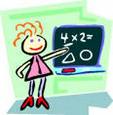|
Number and Operations in Base Ten 5.NBT
|

www.rcs.k12.va.us
|
 www.rcs.k12.va.us |
|
Understand the place value system. 1. Recognize that in a multi-digit number, a digit in one place represents 10 times as much as it represents in the place to its right and 1/10 of what it represents in the place to its left. 2. Explain patterns in the number of zeros of the product when multiplying a number by powers of 10, and explain patterns in the placement of the decimal point when a decimal is multiplied or divided by a power of 10. Use whole-number exponents to denote powers of 10. 3. Read, write, and compare decimals to thousandths. a. Read and write decimals to thousandths using base-ten numerals, number names, and expanded form, e.g., 347.392 = 3 100 + 4 10 + 7 1 + 3 (1/10) + 9 (1/100) + 2 (1/1000). b. Compare two decimals to thousandths based on meanings of the digits in each place, using >, =, and < symbols to record the results of comparisons. 4. Use place value understanding to round decimals to any place. Perform operations with multi-digit whole numbers and with decimals to hundredths. 5. Fluently multiply multi-digit whole numbers using the standard algorithm. 6. Find whole-number quotients of whole numbers with up to four-digit dividends and two-digit divisors, using strategies based on place value, the properties of operations, and/or the relationship between multiplication and division. Illustrate and explain the calculation by using equations, rectangular arrays, and/or area models. 7. Add, subtract, multiply, and divide decimals to hundredths, using concrete models or drawings and strategies based on place value, properties of operations, and/or the relationship between addition and subtraction; relate the strategy to a written method and explain the reasoning used. |
Links:
|